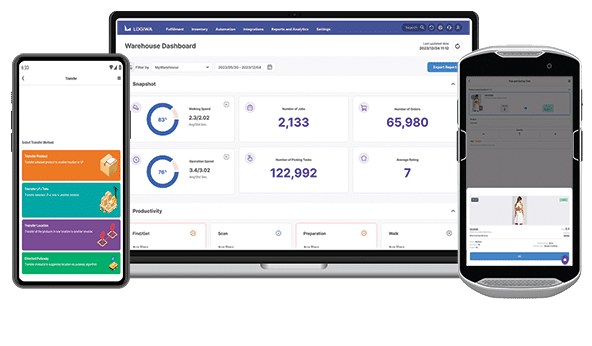In Part 1 of this article, we discussed the increasing importance of the ordering and fulfillment experience in direct-to-consumer business and what that means for peak season operations. Here in Part 2, we’ll discuss investing in technology that can help you deliver the best customer experience for your customers and provide you with a checklist to help the holiday season go smoothly.
Contents
- How a Cloud-Based WMS Solution Could Save Your Season
- The Peak Season Fulfillment Checklist: A Guide to Optimizing Your Warehouse Operations
- Review and Create a Strategic Plan
- Make complete, accurate counts of your inventory
- Increase Your Safety Stock
- Consider an ABC Analysis
- Implement Intelligent Picking and Sorting Strategies
- Smartly Pack It and Ship It
- Don’t Ignore the Basics
How a Cloud-Based WMS Solution Could Save Your Season
We’ve all heard the harsh phrase “adapt or die.” As brutal as it might sound, retailers and warehouses are at a tipping point. Those that can provide positive customer experiences and connections with buyers will thrive. Those that cannot will lose their positions in the market. Remember the lessons of retailers (and their fulfillment centers) that were late to the game with moving online or adapting to the latest technologies and trends (K-mart, Sears, Toys R Us, and Blockbuster to name a few).
Here is where connected, cloud-based warehouse and inventory management software can play a vital role. By deploying cloud-based WMS software with integrations to ecommerce platforms, carriers, accounting systems, ERP platforms, and robotics systems you’re empowered to run fully digitized fulfillment operations to grow your direct-to-consumer or 3PL business.
Using connected workflows, pre-built and customized process automation, and intuitive end-user navigation and controls, fulfillment centers can speed up and streamline everything from inbound operations to their pick, pack, and shipping processes. These solutions remove time-consuming manual tasks and human error from your fulfillment equation, boosting warehouse labor efficiency by as much as 40% while providing a 3X increase in successfully shipped orders over legacy processes.
More importantly, the experience of using a connected, cloud WMS system on the back end can dramatically improve the customer experience on their end, meaning your customers and clients will continue to drive demand for your services.


The Peak Season Fulfillment Checklist: A Guide to Optimizing Your Warehouse Operations
The good news is there’s still time to get your house in order. And even though this year’s holiday season is already upon us, hope is not lost! Let this season be your litmus test to understand where your biggest opportunities lie and what changes need to be made. It is not difficult to increase the customer experience and gain them in the heart. Here are some key things your company should consider:
- Review and Create a Strategic Plan: Review your previous peak season rushes and outcomes – what went right? What went wrong? Identify your biggest areas for improvement. Start hiring and training seasonal workers now, and get them onboarded, trained and up to speed quickly so that by the time the peak of the holiday rush occurs, you have team members that are experienced, confident, and responsive. Ensure your warehouse has more than enough supplies like boxes, tape, labels, and bubble wrap — especially considering the current supply chain issues — so that unnecessary packaging and shipping delays are thwarted.
- Make complete, accurate counts of your inventory: Before peak season it is important to make sure the physical inventory matches with the virtual inventory on the WMS. Inventory discrepancies are the biggest reason for picking operations slowing down. And the more volume of your orders that needs to be picked means that you may encounter more inventory discrepancies issues during picking. While an instant count can give you a one-time accurate look at your inventory in real time, running more continuous cycle counts for your warehouse can provide insights into longer term trends and issues.
- Increase Your Safety Stock: Setting a safety stock limit can help you monitor inventory levels of critical/high throughput SKUs during the peak season. The earlier that a shortage is identified, the better chance you have of restocking in time (and before vendors sell out). Analyze your historical and forecasted sales data and increase your inventory supply to meet the forecasted demand. Learn how to easily calculate safety stock.
- Consider an ABC Analysis: Count operations and setting safety stock limits are helpful but are even more useful if you’re aware of your fastest moving product. An ABC analysis segments your inventory into three key categories by their level of importance. Category A items are regularly counted and tightly controlled. Category B items are counted somewhat regularly and are somewhat controlled. Category C items are counted less frequently and more leniently controlled. This will help you optimize shelf and stock space and picking strategies — prioritizing hot-ticket items and moving them closer to your shipping and fulfillment stations, while deprioritizing items that are not key sellers or holiday push items.
- Implement Intelligent Picking and Sorting Strategies: The staggering increase in ecommerce means that holiday and other peak fulfillment cycles are expected to be even further strained. That means your picking and sorting workflows had better be tip-top to keep up. Why not take advantage of the latest technologies to automate a lot of these repeatable, cumbersome processes. Whether you’re single order picking, cluster picking or batch picking, a digital warehouse management system, can increase your speed and productivity, without having to spend even more hiring, training and managing additional labor assets beyond your typical seasonal help. And the employees you do have manning the floor will work smarter, make fewer mistakes, and have more time to concentrate on more complex issues.
- Smartly Pack It and Ship It: By far one of the biggest warehouse bottlenecks, here is another area where real-time data and automation can simplify and streamline peak-season workflows. With a digital WMS solution, you can set up specialized packing and shipping automations, complete with customized instructions conveyed to packing station staff for different order types. It’s also here where you can use technology to both speed up shipping processes, while saving costs. Use a connected, digital WMS system to combine features like best-rate shopping for carriers, shipping box suggestions, and automatic weight calculations for each order. Even labeling can be optimized when your system has capabilities such as batch printing for same-SKU orders. Digitizing and automating these processes takes the guesswork out the equation and can save you money on both materials and shipping costs.
- Don’t Ignore the Basics: While having a digital warehouse management solution at your disposal can help make sense of some of the most complex fulfillment issues, it can also help you get a leg up on many of those “common sense” practices for running a modern-day warehouse and fulfillment operation. Among them:
- Maintaining an Organized, Clean and Safe Working Environment — Create an intelligent layout design for your warehouse operations and processes that ensure it stays clean, organized, and safe for your teams.
- Having Enough Equipment and Supplies on Hand — From emergency stores of shipping materials to backup printers and scanners, and everything in between, make sure your warehouse isn’t the one looking for last-minute materials — especially in a supply chain crisis!
- Hire Accurately, Hire Early — Peak and holiday seasons mean bringing in extra help. With workforce issues in the spotlight right now, reach out early to find the right workers, train them well and automate their workflows to create rewarding working environments…and they’ll reward you.
- Observe and Report — It’s hard to identify issues and trends to help improve your business if you’re not tracking your processes and consistently reporting on the data. If you are running a modern WMS, these reports should be readily available, so take advantage of them
- Don’t Get Complacent — Even if you’re using the latest technologies in your warehouse, always be looking for new ways to gain efficiencies or scale and grow your business. That includes staying on top of the latest technology trends or talking to your WMS vendor to see how you can maximize the use if your technology.
Your peak and holiday seasons don’t have to be chaos. All it takes is a little planning and the right technologies and your warehouse and fulfillment centers can write their own ticket to success. The biggest plus of this period for you will be the sales success achieved by working together in all your departments, as well as the customer experience you have increased during the challenging period.
Let’s convert to your warehouse to a B2C fulfillment engine. Schedule a Demo
FAQs
What is meant by customer experience?
Your customers can connect with your brand at many points during the pre-sales, the purchasing, and the post-sales processes. Customer experience is the total value your customers place on your brand across all touchpoints.
What is a good customer exerience?
A good customer experience takes into consideration the entire customer journey from making your products and services easy to find, providing clear descriptions of your offerings, making the purchasing process easy, and, more than ever with ecommerce, being able to deliver products on time as promised.
Why is customer experience important?
Customers have more information and options than ever before, especially with the explosion of ecommerce. So more than ever, having easy online purchasing and reliable shipping is becoming the way retailers are differentiating themselves in the market.
How do you create a positive customer experience?
- Create a vision for your ideal customer experience
- Understand your different types of customers and what they value most
- Create an emotional connection with your customers
- Capture customer feedback in real time
- Make sure all departments consider the customer experience in their work.
- Capture feedback from your employees about how to improve customer experience
- Measure the customer experience through methods such as th Net Promotoer Score
- Measure the ROI on positive customer experiences
Pre-integrated with the leading ecommerce, marketplace, shipping and accounting platforms
Warehouse Management
Modern digital WMS powers a modern fulfillment experience






